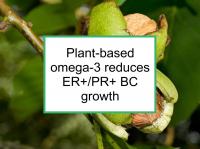Alpha-linolenic acid (ALA) is an omega-3 fatty acid found primarily in a few plant-based foods, including walnuts, flaxseed and their oils. ALA is partially converted in the body to the omega-3 fatty acids eicosapentaenoic acid (EPA) and docosahexaenoic acid (DHA) which are found primarily in fatty fish.
Now a new study has reported that ALA reduces the growth of hormone receptor positive (ER+/PR+) breast cancer cells even in the absence of conversion to EPA or DHA.
Conversion to EPA and DHA can be blocked
As noted above, ALA is converted during metabolism into EPA and DHA, the main omega-3 fatty acids in fish oil. EPA and DHA have been reported to have chemopreventive effects in multiple studies. For example, they have been shown to reduce lung metastasis in a mouse model of breast cancer and to inhibit the early stages of HER2-positive (HER2+) breast cancer. However, the conversion of ALA can be blocked in the presence of vegetable oils with high omega-6 fatty acid content. These include corn oil, safflower oil, soybean oil, and sunflower oil. Therefore, flaxseed, walnuts and their oils should be consumed separately from such oils.
Latest research finds ALA reduces ER+/PR+ growth directly
The study referenced at the beginning of this news story was designed to investigate the mechanism of action by which ALA prevents hormone receptor positive breast cancer growth. ALA has been shown to inhibit ER+/PR+ growth in both cell and animal studies. To conduct the study, the authors treated ER+/PR+ MCF-7 breast cancer cells with 100 µM ALA and 1 nM estradiol (E2). E2 is an estrogen that binds to estrogen receptors alpha (ERα) and beta (ERβ). They then assessed the cell fatty acid profile, mRNA and protein biomarkers compared to control cells treated only with E2. The authors also investigated the effects of the anti-estrogen fulvestrant (Faslodex) in the cells.
Omega-6 to omega-3 ratio and breast cancer risk
In fact, several population studies have reported that it is the ratio of omega-6 to omega-3 fats in the diet that is important, rather than the absolute intake. For example, one Chinese study found that women with both the lowest consumption of marine omega-3 fats (from fish) and the highest intake of omega-6 fats had double the risk of breast cancer of women who had both the highest marine omega-3 fat consumption and the lowest omega-6 fat intake.
Some observers have suggested that human beings evolved on a diet with an omega-6 to omega-3 ratio of approximately 1-to-1. This was in part because meat from wild or grass-fed animals has a much higher omega-3 content than that of corn- and soy-fed animals. In addition, people consumed far less vegetable oils. Today, the typical U.S. diet has an omega-6 to omega-3 ratio estimated to be at least 15-to-1. The ideal dietary omega-6 to omega-3 ratio for cancer prevention has not been determined, but it appears to be 3-to-1 or lower.
ALA was found to be incorporated into breast cancer cells but not further metabolized. In other words, no conversion to EPA or DHA occurred. ALA altered the mRNA expression of targets either regulated by or that regulate estrogen receptors. This included caveolin-1, survivin and progesterone receptor. Lower cyclin-D1, progesterone receptor, caveolin-1 and higher ERα protein expression were observed in cells treated with ALA. On the other hand, co-incubation with the anti-estrogen fulvestrant cancelled the growth-reducing effects of ALA. The authors conclude that ALA might reduce ER+/PR+ breast cancer cell growth by influencing estrogen receptor-related signaling. This suggests a possible mechanism for the chemopreventive effects of ALA that is independent of its metabolites.
Please see our article on what hormone receptor positive breast cancer patients and survivors should eat for more information.
